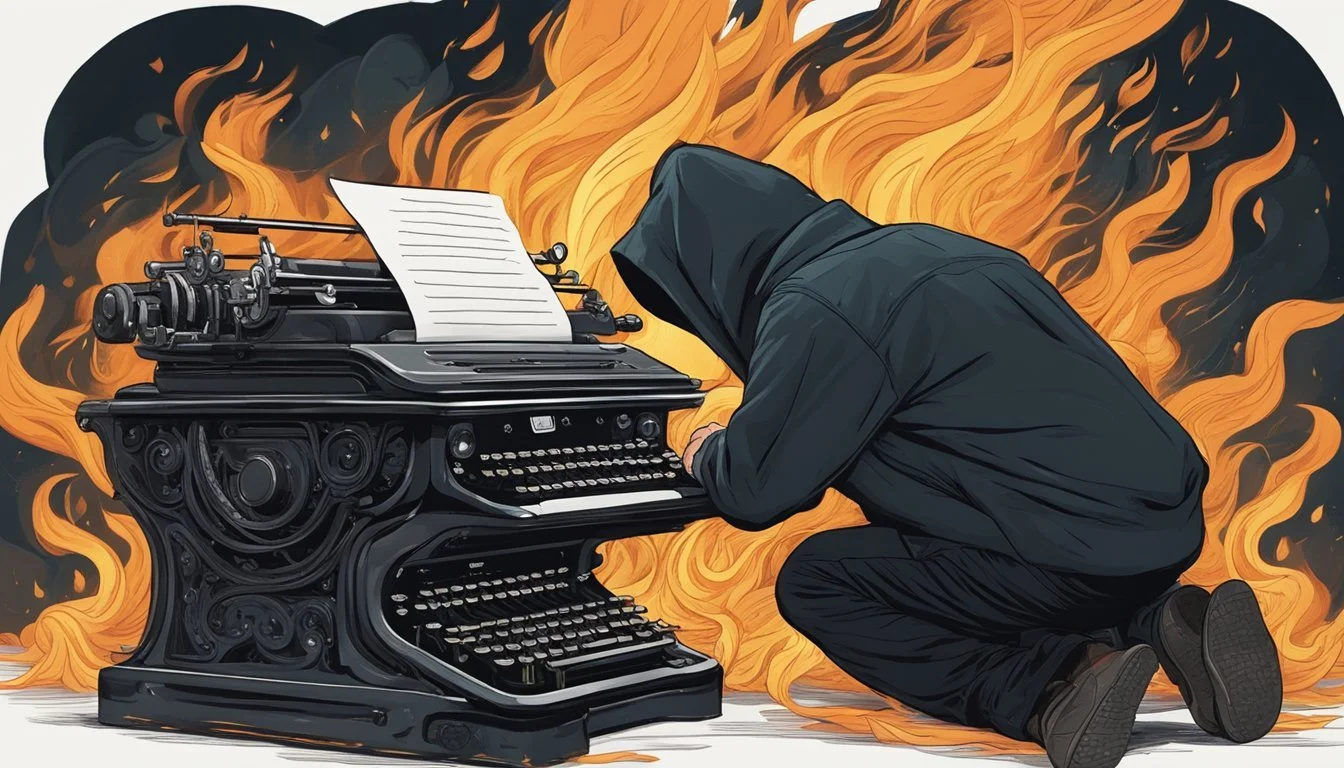Letters from Hell: David Berkowitz and the Son of Sam Saga
A Criminal Correspondence Exposed
In the summer of 1976, New York City was gripped by fear as a serial killer targeted young couples in parked cars. The murderer, later identified as David Berkowitz, became known as the "Son of Sam" after a chilling letter left at a crime scene. Berkowitz's reign of terror lasted until his arrest in August 1977, leaving six people dead and seven wounded.
The letters penned by Berkowitz during his killing spree offer a disturbing glimpse into the mind of a serial killer. In one letter addressed to NYPD Captain Joseph Borelli, Berkowitz expressed anger at being called a "woman hater" and taunted police for their inability to catch him. These messages, filled with cryptic references and threats, heightened public anxiety and fueled media frenzy.
After his capture, Berkowitz continued to write letters from prison, providing insights into his motivations and state of mind. His correspondence has been studied by criminologists and psychologists, shedding light on the complex psychology of serial killers. The Son of Sam saga remains one of the most infamous criminal cases in American history, with Berkowitz's letters serving as haunting reminders of the fear that once paralyzed New York City.
The Son of Sam Phenomenon
David Berkowitz terrorized New York City in the mid-1970s, sparking widespread fear and a media frenzy. His brutal attacks and taunting letters to the press captivated public attention and left an indelible mark on American crime history.
David Berkowitz: A Brief Profile
Born Richard David Falco in 1953, David Berkowitz was adopted as an infant. He served in the U.S. Army before working as a postal employee in New York City. Outwardly unremarkable, Berkowitz harbored deep-seated psychological issues that would later manifest in violent ways.
His troubled childhood and feelings of rejection contributed to his antisocial behavior. Berkowitz lived alone in Yonkers, north of New York City, at the time of his crimes.
Moniker and Media Sensation
The "Son of Sam" moniker originated from Berkowitz's first letter to the police, where he referred to himself by this name. New York media outlets, particularly the New York Daily News, seized on this dramatic self-title.
Columnist Jimmy Breslin played a significant role in publicizing the case. His articles, including excerpts from Berkowitz's letters, fueled public fascination with the killer.
The media coverage intensified the city's fear and turned Berkowitz into a household name. His cryptic messages and the hunt to identify him dominated headlines for months.
The .44 Caliber Shootings
Berkowitz's killing spree began in July 1976 and lasted until his arrest in August 1977. He targeted young couples and women with long, dark hair, primarily in the Bronx, Queens, and Brooklyn.
Using a .44 caliber Bulldog revolver, Berkowitz attacked his victims late at night, often as they sat in parked cars. His seemingly random selection of targets heightened public panic.
The shootings left six people dead and seven wounded. The killer's ability to evade capture for over a year despite an intensive police manhunt added to the growing mythos surrounding the Son of Sam.
Letters from the Abyss
David Berkowitz's letters provided chilling insights into the mind of a serial killer. These writings captivated the public, fueled media speculation, and challenged law enforcement's understanding of the case.
Communicating With New York Daily News
Berkowitz sent his first letter to the New York Daily News in May 1977. The newspaper initially withheld publication, running teaser articles to build anticipation. When finally revealed, the letter shocked readers with its disturbing content.
Addressing Captain Joseph Borelli, Berkowitz wrote, "I am deeply hurt by your calling me a wemon hater. I am not." He signed the letter "Son of Sam," a moniker that would become infamous.
The killer taunted police, writing, "I'll be back! I'll be back!" This brazen communication intensified public fear and frustration with law enforcement's inability to catch the perpetrator.
Beyond the Law: Cult Theories
Maury Terry, an investigative journalist, proposed that Berkowitz was part of a larger satanic cult. His theory suggested the Son of Sam killings were ritualistic murders involving multiple perpetrators.
Terry's work pointed to inconsistencies in witness descriptions and ballistics evidence. He argued that Berkowitz's letters contained hidden messages and symbols linking him to occult practices.
While official investigations dismissed these claims, Terry's theories gained a following. Some believed Berkowitz's writings hinted at a broader conspiracy involving demons and dark rituals.
Psychology of a Serial Killer
Berkowitz's letters offered a window into his disturbed psyche. Mental health professionals analyzed his writings for clues about his motivations and state of mind.
His communications revealed a mix of grandiosity and self-loathing. In one letter, he wrote, "I am merely a sinner," while in others, he portrayed himself as an unstoppable force.
Experts noted signs of paranoia and delusions in Berkowitz's writings. His references to demons and being controlled by outside forces suggested severe mental illness.
The letters also displayed a need for attention and recognition, common traits among serial killers. By communicating with the media, Berkowitz sought to control the narrative and extend his notoriety.
Investigation and Arrest
The Son of Sam case sparked an intense police manhunt that gripped New York City. As the killer evaded capture for months, investigators pursued multiple leads and strategies before a crucial breakthrough finally led to David Berkowitz's arrest.
NYPD's Approach to the Case
The New York City Police Department formed a special task force to track down the Son of Sam killer. Captain Joseph Borrelli led the investigation, which involved hundreds of detectives.
The task force followed up on thousands of tips from the public. They also analyzed ballistics evidence and handwriting from the taunting letters sent to police and the media.
Investigators interviewed survivors and witnesses, creating composite sketches of potential suspects. The police offered a $10,000 reward for information leading to an arrest.
The Parking Ticket Breakthrough
The case broke open due to a seemingly minor detail - a parking ticket. On July 31, 1977, a witness reported seeing a man with a gun near the scene of the latest shooting.
The witness also noted a parking ticket on a nearby car. Detectives traced the ticket to a car registered to David Berkowitz in Yonkers, New York.
This crucial lead allowed police to identify Berkowitz as a prime suspect. They quickly mobilized to surveil his apartment building and gather more evidence.
Craig Glassman and Berkowitz's Neighbors
Craig Glassman, Berkowitz's upstairs neighbor, provided key information to investigators. He reported receiving threatening letters from Berkowitz and hearing strange noises from the apartment.
Other neighbors described Berkowitz as a loner with odd behavior. Some recalled seeing him lurking around the neighborhood late at night.
These accounts bolstered the case against Berkowitz. On August 10, 1977, police arrested him outside his apartment building. The year-long manhunt had finally come to an end.
Victims and Impact
The Son of Sam attacks left a trail of death, injury, and fear across New York City. Berkowitz's reign of terror claimed lives, shattered families, and fundamentally altered the city's atmosphere.
Profiles of the Stricken
Donna Lauria, 18, became the first victim on July 29, 1976. Shot while sitting in a car with her friend, she died instantly. Stacy Moskowitz, 20, was the final fatality on July 31, 1977. She was killed while on a date with Robert Violante, who survived but was blinded.
In total, Berkowitz killed six people and wounded seven others. His victims were predominantly young women with long, dark hair, though some men were also targeted.
The attacks seemed random, occurring in different boroughs and targeting people in cars or on the street.
New York Under Siege
Fear gripped New York as the shootings continued. Women cut or dyed their hair, hoping to avoid the killer's attention. Streets emptied after dark, and social life ground to a halt.
Police mounted the largest manhunt in the city's history. Citizens formed neighborhood watch groups. The media frenzy amplified public anxiety, with sensational headlines and constant coverage.
The killer's taunting letters to police and journalist Jimmy Breslin added to the tension. New Yorkers lived in a state of constant vigilance and suspicion.
Aftermath and Survivors
The Son of Sam's capture brought relief but left lasting scars. Survivors like Robert Violante faced ongoing physical and emotional challenges. Many victims' families struggled with grief and trauma for years.
The city's psyche was permanently altered. The attacks spawned books, movies, and lasting cultural references. Laws were changed, allowing victims to profit from criminals' notoriety.
Some survivors found hope through advocacy work. Others preferred privacy. The Son of Sam saga remains a dark chapter in New York's history, remembered with a mix of fascination and dread.
Cultural and Media Influence
The Son of Sam case captivated the public and media, leaving a lasting impact on popular culture. It spawned films, books, documentaries, and true crime narratives that continue to fascinate audiences decades later.
Summer of Sam and Spike Lee
Spike Lee's 1999 film "Summer of Sam" brought the case to the big screen. The movie portrayed New York City gripped by fear during the Son of Sam killings. Lee's film focused on the paranoia and tensions in a Bronx neighborhood as residents grappled with the looming threat.
The movie featured John Leguizamo and Mira Sorvino, depicting how the manhunt affected relationships and community dynamics. While not a direct retelling of the Berkowitz crimes, "Summer of Sam" captured the era's atmosphere of suspicion and unease.
Lee's film sparked renewed interest in the case, introducing a new generation to the Son of Sam saga.
From Newsprint to Netflix
Media coverage of the Son of Sam case evolved from sensational newspaper headlines to streaming documentaries. In 1977, New York tabloids competed for scoops, with the Daily News publishing Berkowitz's letters.
The case resurfaced in 2021 with Netflix's docuseries "The Sons of Sam: A Descent into Darkness." This four-part series explored journalist Maury Terry's theory that Berkowitz didn't act alone.
Netflix's production reignited public interest, presenting new perspectives on the decades-old case. It highlighted how media narratives around serial killers have shifted over time.
True Crime Narratives
The Son of Sam case became a staple of true crime literature and podcasts. Authors and creators continue to analyze Berkowitz's crimes, letters, and motives.
Books like "The Ultimate Evil" by Maury Terry delved into conspiracy theories surrounding the case. Podcasts such as "Son of Sam | The Hunt for a Killer" offered in-depth examinations of the investigation.
These narratives often explore the psychological aspects of Berkowitz's crimes and the impact on victims' families. They reflect society's ongoing fascination with understanding the minds of serial killers.
True crime content keeps the Son of Sam case in the public consciousness, sparking debates about criminal psychology and media ethics.
Legal Proceedings and Incarceration
David Berkowitz faced swift justice after his arrest in 1977. His trial and subsequent sentencing marked the end of the Son of Sam saga, while his life behind bars has been characterized by religious conversion and denied parole requests.
Trial and Sentencing
Berkowitz's trial began on May 8, 1978, in Westchester County, New York. He initially pleaded not guilty by reason of insanity but later changed his plea to guilty for all charges. The trial lasted just 15 minutes.
On June 12, 1978, Berkowitz was sentenced to 25 years to life for each of the six murders. The sentences were to be served consecutively, effectively ensuring he would spend the rest of his life in prison.
Judge Joseph Corso described Berkowitz as a "dangerous person" during the sentencing, emphasizing the gravity of his crimes.
Life Behind Bars
Berkowitz has been incarcerated in various New York state prisons since his sentencing. In the 1980s, he claimed to have experienced a religious conversion, becoming a born-again Christian.
He has been denied parole multiple times, most recently in May 2024. The parole board consistently cites the heinous nature of his crimes as the reason for denial.
Berkowitz has expressed remorse for his actions and participates in prison ministry programs. He works as a peer counselor, assisting mentally ill inmates.
Despite his attempts at rehabilitation, Berkowitz remains one of New York's most infamous prisoners, serving his sentence at Shawangunk Correctional Facility.
Reinvestigations and Conspiracies
The Son of Sam case has sparked numerous alternate theories and investigations over the years. Some researchers and authors have proposed more complex explanations for the killings beyond Berkowitz acting alone.
Advocates for Alternate Theories
Maury Terry, an investigative journalist, became a prominent advocate for conspiracy theories surrounding the Son of Sam murders. In his book "The Ultimate Evil," Terry argued that Berkowitz was part of a wider Satanic cult responsible for the killings. He pointed to inconsistencies in witness descriptions and ballistics evidence.
Terry claimed John Carr, Berkowitz's neighbor, was involved in the murders. He also alleged connections to other unsolved cases and occult activities. Some former detectives supported Terry's theories, leading to renewed public interest.
Despite Terry's efforts, official investigations maintained Berkowitz acted alone. Critics argued Terry's claims lacked solid evidence and relied heavily on speculation.
The Ultimate Evil Investigation
"The Ultimate Evil" investigation, inspired by Terry's book, delved deeper into potential cult connections. Researchers examined possible links between the Son of Sam killings and other crimes across the country.
The investigation explored claims of a nationwide Satanic network. It looked into alleged connections to arson cases, animal mutilations, and other unsolved murders. Some former law enforcement officials contributed to this alternate narrative.
While intriguing, the "Ultimate Evil" theories remained largely unproven. Official law enforcement agencies rejected most of these claims as unfounded. The investigation highlighted the enduring public fascination with complex conspiracy theories surrounding high-profile crimes.
Transformation and Redemption
David Berkowitz's journey from notorious serial killer to reformed inmate highlights the power of personal transformation. His conversion to Christianity and subsequent faith-based activities in prison marked a significant shift in his life trajectory.
Conversion to Christianity
Berkowitz's spiritual awakening occurred in 1987, a decade after his arrest. He claimed to have encountered Jesus Christ in his prison cell, leading to a profound change in his outlook. This experience prompted him to renounce his past crimes and seek forgiveness.
Berkowitz began studying the Bible intensively, finding solace and guidance in its teachings. He embraced Evangelical Christianity, viewing it as a path to redemption and personal growth.
The sincerity of his conversion was initially met with skepticism by many, given the gravity of his crimes. However, over time, some observers noted consistent changes in his behavior and attitudes.
The Role of Faith in Prison
Berkowitz's newfound faith became a central aspect of his life behind bars. He participated actively in prison ministry programs, offering support to fellow inmates struggling with their own spiritual journeys.
He started writing letters to Christian organizations and individuals, sharing his experiences and expressing remorse for his past actions. These communications often included biblical references and reflections on his spiritual growth.
Berkowitz's involvement in faith-based activities extended to leading Bible study groups within the prison. He used his story as a cautionary tale, emphasizing the transformative power of Christianity to those seeking change.
His efforts in prison ministry garnered attention from some religious leaders, who viewed his case as an example of redemption through faith. This led to occasional speaking engagements via phone or video to church groups outside the prison walls.






